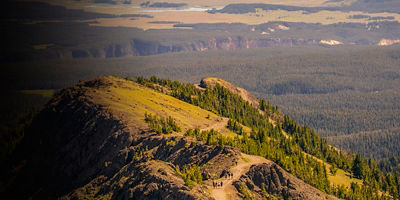Seasons
Winter
Winter brings snowfall, which creates a beautiful scene unlike any other: White snow contrasts red rock surrounding fields of hoodoos, punctuated by dark-green pine, spruce, and fir trees. The Bryce Canyon Winter Festival takes place each January, with cross-country ski and snowshoe tours, archery clinics, fat-biking opportunities and more. A Christmas Bird Count, led by the Audubon Society, happens each December. Some roads and trails within the park close due to snow.
Spring
Daytime temperatures (around 50 degrees) make this transition season a cool, but pleasant time to visit. Occasional snowfall provides a treat, though one that can make trails slick with ice or mud. Evenings can dip below freezing, so come prepared. Spring is considered the rainy season, but rainfall is sparse—stay aware of afternoon showers that can create flash-flooding risks.
Summer
The busy season in Bryce is between May and September, so be prepared for crowds. Since the park sits between 8,000–9,100 feet, temperatures rarely exceed 90 degrees during the daytime, with an average high of 80 degrees in July (June and September have average highs of 64 and 70, respectively). Thunderstorms are frequent in July and August, but those summer evenings are cool and pleasant.
Fall
Like spring, autumn means unpredictable weather. But a clear fall day in Bryce can yield a fantastic experience with sunshine and blue skies, crisp mornings and cool evenings. Rainfall increases in October, and snow begins to fall intermittently.
Activities
Bryce Canyon is a hiking destination year-round—though winter outings may require snowshoes after a fresh snow, or traction devices after the snow has been packed down. While hiking is the most popular way to experience the park’s splendor, it’s certainly not the only activity to get you off the road and further into the park.
Take a Hike
Navajo Loop/Queen’s Garden Trails: This popular 2.9-mile hike leads to some of the park’s most scenic sections. Start from Sunrise Point on the Queen’s Garden Trail, dropping down gradually from the canyon rim before meeting up with a short detour to the trail’s namesake feature: a hoodoo that resembles Queen Victoria. The trail continues for 0.8 miles before connecting to the Navajo Loop Trail. Choose from two trail options to ascend the 600 feet back up to the rim, with the Wall Street Trail (0.7 miles) being the more popular choice (over the 0.6-mile Two Bridges Trail). Then walk 0.5 miles along the Rim Trail from Sunset Point to where you started at Sunrise Point. Note: You can also start at Sunset Point and do the 0.5 miles on the Rim Trail first.
Peekaboo Loop Trail: If you start this 4.95-mile hike at Bryce Point, you’ll cover 2,648 feet of elevation gain into just over 5 miles, so be ready to climb. Descend on the Peekaboo Loop Connector Trail to reach the Peekaboo Loop Trail, enjoying sights like the Cathedral Spire, the Fairy Castle Spire, and the Wall of Windows (a series of sandstone arches). Starting at Sunset or Sunrise Point, head down the Wall Street or Two Bridges trails to connect to the Peekaboo Loop before climbing “just” 1,997 feet back up.
Fairyland Trail: This is a challenging, 8.3-mile hike that descends to the bottom of Fairyland and Campbell canyons and winds around Boat Mesa, a massive rock formation that looks like—you guessed it—a boat. Pass by the pair of natural arches dubbed the Tower Bridge as well as the impressive row of hoodoos called China Wall. The route starts at Fairyland Point on the north end of the park and returns to your starting point along the Rim Trail.
Go Camping
One hundred car-camping sites are available at the North Campground, located right across the road of the Visitor Center. This campground is open year-round. The Sunset Campground, 1.5 miles south of the Visitor Center, has 99 sites available and is open May through October.
Go Backpacking
A few different trails lead down into the canyon floor and offer opportunities to camp in a designated backcountry campsite. The 22.9-mile Under-the-Rim Trail (Bryce Point to Rainbow Point) has seven sites along the trail. Three single sites and a group site are available along the 8.8-mile Riggs Spring Loop Trail (accessible via Yovimpa Point). Backcountry permits are required and accessible via the park’s Visitor Center.
Go Cross-Country Skiing
Winter exploration on cross-country skis can be magical in Bryce Canyon National Park. Though you can’t ski down into the canyon, you can schuss on sections of the Rim Trail along the edge of the Main Amphitheater and the Bristlecone Loop trails, on the Paria Ski Loop, or on the unpaved Paria View and Fairyland Point roads. (Ruby’s Inn, located in nearby Bryce, Utah, rents cross-country ski gear.)
Go Horseback Riding
Canyon Trail Rides offers guided horseback rides into the canyon between April or May through the end of October. Equestrians can also bring their privately owned horses to ride some of the park’s trails (specific date reservations required).
Go Cycling
Cyclists enjoy riding the 18-mile shared-use path that starts in Red Canyon at the Thunder Mountain Trailhead outside of the park and ends at Inspiration Point within the park.


















